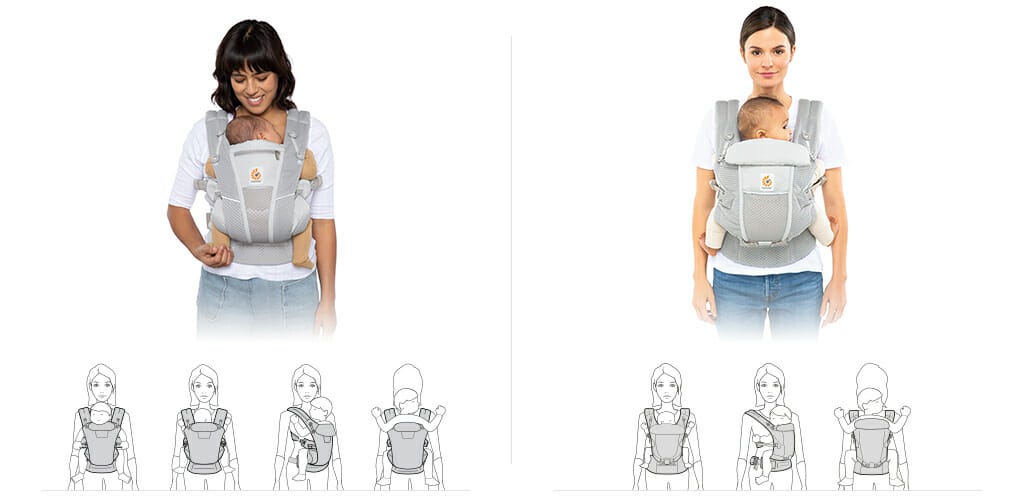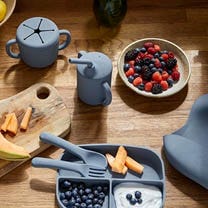
It's not easy to navigate your way through so many baby carriers in our range, especially when the carriers can seem so similar at first glance.
We are asked questions about our bestsellers, the Omni and the Adapt time and again. Questions like, How do the two baby carriers differ and which one should I choose?

We would like to take a deeper look at these two carriers below to explain the similar points, differences and help you decide which carrier would best suit your needs.
The range of our baby carriers is growing
Ergobaby offers a wide range of ergonomic baby carriers, in different materials and in a variety of designs. There is a suitable product to meet your needs. However, this doesn't make the decision any easier.
Let’s start from the beginning of our Ergobaby baby carriers journey. In 2002 we launched the Original Ergobaby baby carrier. For this carrier a newborn insert in needed from birth.
Thanks to the constant development of our products, we now have ergonomic carriers that grow with baby from birth without an infant insert and you can carry your baby in different positions. Our most popular carriers are the Omni and Adapt designs. Even though they are two different models, it is clear that besides some differences (like fit, number of carrying positions and price), there are also many similarities.

During the summer of last year, we launched a new version of the Omni 360, the Omni Breeze (SoftFlex™Mesh) and Omni Dream (SoftTouch™Cotton). In September further development of the Adapt was introduced in exactly the same materials. It sounds confusing, so let’s look at these two carriers in more detail.
OMNI and ADAPT - what they have in common:
Both carriers are ergonomic with a wide, well-padded waist belt, a comfortable and adjustable lumbar support for the parents and an adjustable, very ergonomic fit for the child.
Here is an overview of the most important features of both carriers:
- Usable from approx. 3.2 to approx. 20.4 kg.
- Full-buckle carriers, i.e. they only have buckles, for the best weight distribution with the easiest use.
- Correct spread squad position for the child (M position).
- 3-point comfort system for parents, consisting of lumbar support, high-quality padded shoulder straps and the chest strap. This distributes the child's weight evenly over parents body, even on longer trips, similar to a hiking backpack.
- The shoulder straps in the back can be crossed if even more stability or a different carrying method is needed which can often be more comfortable for petite wearers.
- The same great new materials: even thinner mesh for even more breathability and even softer brushed cotton for snug comfort.
- The same fit for parents: slimmer and slightly thinner shoulder straps than the predecessors.
- Velcro adjustment on the inside of the waist belt allows the carrier to grow with the child.
- Padded headrests with three adjustment options for baby's growth and development.
- A large hood that also protects against the sun as a headrest for older children, especially when carried on the back.
- More safety for active parents thanks to reflectors on the mesh models.
- Easy adjustment of all buckles and straps.
- Like all our carriers, machine washable at 30 degrees.
OMNI and ADAPT: What's the difference?
Unlike the Adapt, the Omni Breeze and Omni Dream have a detachable pouch on the waist belt and small side pockets to help carry all those little things when out and about.
However the most important difference, lies in the carrying positions. Omni offers you four instead of three carrying positions. You can carry your child inward facing, on the hip and on the back with both carriers. The Omni family (360, Omni 360, Omni Breeze and Dream) allow your child to see all around with the additional outward facing position, your child looking forwards. We recommend this position from around 5 to 7 months, when your baby has strong head and neck control, starts showing interest in the world around them and their chin is above the carrier panel and the child is sitting in an ergonomic spread-squat position (M position). The important thing with this carrying method is a low-stimulus environment and an awake state. Then you can put your baby in this position for about 10 to 20 minutes so that you can do something together. You can explore your garden by watering the flowers or mix the ingredients to bake some cupcakes.
Top tip: there is nothing more practical than simply putting your child who cannot yet sit (milestone sitting: from 9 months) in an outward facing position whilst sat eating dinner or relaxing on the sofa, giving you two free hands. The outward facing position is not recommended for long walks in the woods or crowded Christmas markets due to overstimulation but you can use the inward facing or back carry to get those snuggles while you are out and about.

3 or 4 carrying positions - How many do you need?
With the fourth (outward facing) carrying position, we adapted the fit for your child, to ensure this position was also ergonomic. That's why the Omni Breeze and Omni Dream Carriers have adjustable sliders, so that the back panel can be tightened for the appropriate carrying position. The Adapt has an additional webbing strap and can be individually adjusted in width by means of three poppers.
There is one simple question that you need to ask to decide whether the Omni or Adapt baby carrier is right for you: Do you need the fourth, additional carrying position, front/outward facing carry? Of course, this is also the reason for the price difference too.
If you are still unsure which carrier to choose, it is best to try on both models and see how the carrier feels. We have our Omni and Adapt carriers stockists in National and Independent baby stores across the UK and Ireland.
If you have any further questions, our trained babywearing advisors in our customer service department are avialable to answer any questions: customersupport@ergobaby.co.uk
Additional product information and instructional videos can be found on our Ergobaby online shop https://ergobaby.co.uk/instructions




















